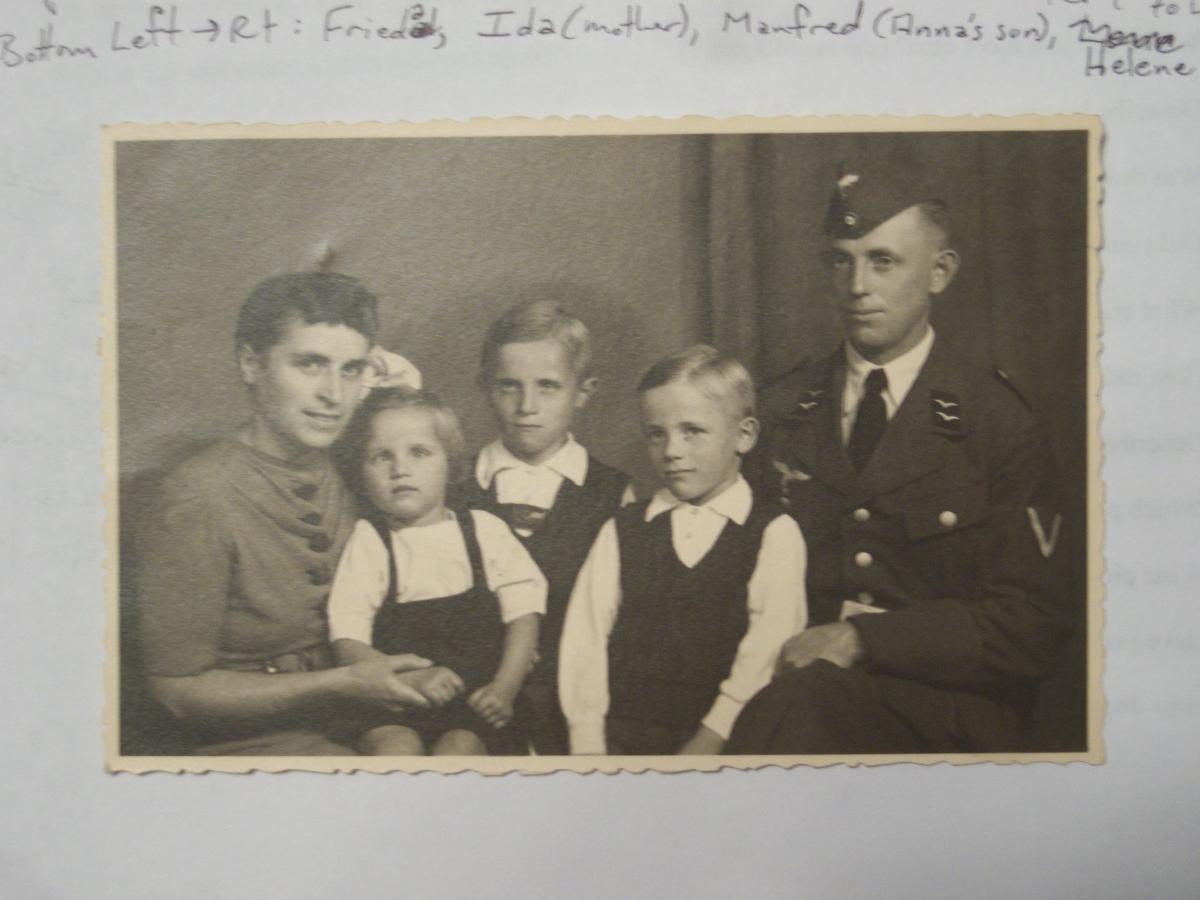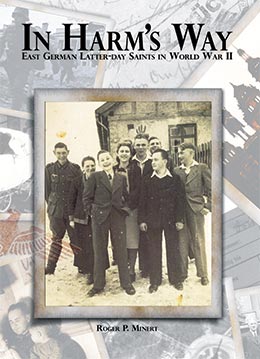Mittweida Branch, Chemnitz District
Roger P. Minert, In Harm’s Way: East German Latter-day Saints in World War II (Provo, UT: Religious Studies Center, Brigham Young University, 2009), 199-201.
Located just ten miles north of Chemnitz, the town of Mittweida had about 24,000 residents in 1939. Only twenty-three of them were members of The Church of Jesus Christ of Latter-day Saints. Church meetings were held in rented rooms at Max Beulich Strasse 10 at the time.
| Mittweida Branch[1] | 1939 |
| Elders | 1 |
| Priests | 1 |
| Teachers | 3 |
| Deacons | 1 |
| Other Adult Males | 3 |
| Adult Females | 12 |
| Male Children | 2 |
| Female Children | 0 |
| Total | 23 |
In a branch history written by Johannes Jentzsch, we find the following comments for the year 1939:
The building in which we were holding our meetings, the “House of the German Laborer,” was purchased by the city of Mittweida. They pressured us to leave based on the supposed need for renovations. Our meeting times were often changed and sometimes the meetings were cancelled. On September 24, a sacrament meeting was held at the home of Max Jentzsch in Weinsdorf [two miles northeast]. Finally, we found another meeting place for the branch, a little side building on Schulstrasse, across from the Fischte School. The owner was a Jewish man named Lässer. The average attendance at all meetings was twelve persons—four friends and eight members.[2]
Johannes Jentzsch recalled the branch conference held on October 15, 1939. District president Karl Göckeritz presided and was asked if Germany would win the war. He replied, “Israel will win the war.”
According to the branch history, Johannes Jentzsch was picked up from his place of work and taken into custody by the Gestapo in 1940. He narrowly missed being sent to the Buchenwald Concentration Camp, based on the charge that Latter-day Saint preachers told people to refuse to do work on Sundays during wartime.
The average attendance at meetings during 1940 was nine persons (seven members and two friends). By January 1941, the meeting rooms had moved to Heinrich Gutsche Strasse 7.[3] There is no information as to the reason for the move. The attendance at meetings in 1941 continued to decline. Mothers were required to join the general work force and thus miss meetings. The branch president, Max Jentzsch, had to walk or ride a bicycle from his home in Weinsdorf to Mittweida, though he still suffered from wounds received in World War I.
“I always enjoyed going to church, even though we had to walk for about a half hour. We did it twice on Sunday and also during the week,” explained Reiner Lässig (born 1935).[4] His sister, Annemarie (born 1939), recalled how they held hands as they walked to church. Between Sunday School and sacrament meeting, they would visit their uncle and their grandmother.[5]
During the year 1942, members of the branch were again subjected to some harassment. For example, Max Jentzsch was told by a Nazi Party member that the Church would be “totally wiped out” when the war was over. Emil Heidler of the district presidency recommended that the sign “Kirche Jesu Christi der Heiligen der Letzten Tage” be removed from the building where the meetings were held. By the end of the year, the only brethren left at home were Max Jentzsch and Walter Lässig. Despite the hardships of the war years, the average attendance at meetings had increased to thirteen (twelve members and one friend).
The report for the year 1943 begins with these words: “The war has taken a decided turn. On all fronts we are retreating.” The members became more united under the stress, and the average attendance rose to seventeen members and friends. At times, the brethren could not attend and meetings were cancelled. Sacrament meeting was held immediately following Sunday School.
As a boy, Reiner Lässig went to the movie theater on occasion and recalled the following impressions:
They always had a special news reel about the war, always saying how well [the soldiers] were doing. They never told us about the bad times toward the end of the war [or] when they were close to Stalingrad, when they had problems. They never told us about that.[6]
Reiner was baptized in a reservoir called the Stahlbecken just outside of Mittweida. It was 1944, and he was nearly nine years old.
 The family of Ida and Otto Lässig (R. Lässig)
The family of Ida and Otto Lässig (R. Lässig)
Walter Lässig, Reiner’s father, spent at least three years in the uniform of the Wehrmacht. His children later explained that he came home only twice. According to little Annemarie, “When my dad came to visit, I followed him around all the time. I think I even followed him into the bathroom because we never saw him very much, and we just wanted to get his attention while he was there.”
Unofficial branch historian Johannes Jentzsch wrote that branch president Max Jentzsch was the only priesthood holder left at home during 1944, until Paul Emmerlich was released from the army. Sunday School still took place every week and sacrament meeting took place on thirty-four different Sundays during the year. The average attendance was again seventeen persons. Regarding the end of the war, the branch history reads as follows:
On April 15 the enemy approached [Mittweida], so meetings were not held. The Americans took Mittweida without any fighting, but German defenders were in Weinsdorf, where branch president Max Jentzsch lived, and fighting took place there until the Russian army approached from Hainichen. On April 22, while the Jentzsch home was being hit by artillery shells, members gathered with Paul Emmerlich in Mittweida to hold a meeting at the usual hour.
Annemarie Lässig recalled the terror she felt when enemy artillery was heard near Mittweida:
We woke up many times that night, and my mother grabbed us and ran down the stairs. We were down in the basement sitting together on a sled. My mother said a prayer. I remember the noise and the glass shattering, but she said a prayer, and we felt comforted that nothing would happen to us, but we were all pretty scared down there.
Young Reiner Lässig recalled how the American soldiers treated children during the two months they were in Mittweida as occupation forces. Two quite different experiences were unforgettable:
I remember one whose name was Jim. I will never forget his name. He used to bring out his C rations . . . and packages from home and share them with us. He took us on jeep rides. But there was another American, an American Jew. I will never forget his face [with his] thick glasses. He would come out with C rations, . . . pour gasoline all over them, in front of the kids, and would burn them. . . . He hated Germans that bad. . . . But most of them were really nice.
Reiner’s impression of the Soviet soldiers was also distinct years later. They arrived in July 1945 and conditions changed drastically: “Most of the time they didn’t have shoes; they just had rags wrapped around their feet. Then the women had to hide. I don’t blame the Russian soldiers [for their misdeeds]; they were so uneducated.”
Fortunately, almost all of the members of the Mittweida Branch survived the war. As they came home one by one, the branch that had never given up was revived.
In Memoriam
The following members of the Mittweida Branch did not survive World War II:
Karl Moritz Laessig b. Wildenfels, Zwickau, Sachsen 30 Jul 1872; son of Hugo Oswald Laessig and Marie Christiane Werner; m. Schönau, Zwickau, Sachsen 9 May 1897, Ida Auguste Lauckner; 6 children; d. Wildenfels 11 Sep 1941 (IGI)
Alma Richter b. Lauter 22 Apr 1869; m.; d. 2 Mar 1944 (History of Mittweida Branch; FHL Microfilm 271402)
Notes
[1] Presiding Bishopric, “Financial, Statistical, and Historical Reports of Wards, Stakes, and Missions, 1884–1955,” CR 4 12, 257. Annemarie Lässig Ferrari, interview by Michael Corley, Riverton, Utah, March 29, 2008.
[2] Johannes Jentzsch, “History of the Mittweida Branch” (unpublished history, about 1992); private collection; trans. the author.
[3] East German Mission, “Directory of Meeting Places” (unpublished manuscript, January 31, 1943); private collection.
[4] Reiner Lässig, interview by Michael Corley, Riverton, Utah, March 29, 2008.
[5] Annemarie Lässig Ferrari, interview by Michael Corley, Riverton, Utah, March 29, 2008.
[6] The German Sixth Army surrendered at Stalingrad, Russia, in February 1943. The loss of 295,000 men heralded the defeat of Hitler’s Third Reich in the minds of many Germans.
 The choir of the Chemmitz District
The choir of the Chemmitz District
